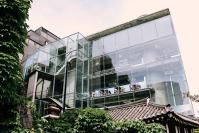Arario Museum 아라리오뮤지엄
- Naeem Adam
- Jun 4, 2015
- 2 min read
I sometimes find myself dumbfounded, not by the exhibition, but by the capsule within which the exhibition takes place.

Within close proximity to Seoul’s Changdoekgung Palace lies the iconic Arario Museum. Initially designed and occupied by Kim Swoo-geun (1939-86) and his architectural firm Space Group, the structure now exists as a successfully converted adaptive-reuse project, a spatial marvel exhibiting notable works by Tracy Emin and Andy Warhol.
The Space complex aesthetically exists in complete contrast where an ivy-covered brick building (designed by Kim) is juxtaposed so eloquently beside a contemporary glass structure (constructed after his death), and a reconstructed hanok (a traditional Korean house). This exterior aesthetic gives clear indication of the historical palimsest the building exhibits, not only technologically but also in its theoretical and artistic narrative. The building’s original form has been preserved as much as possible, creating interesting interior spaces which facilitate in displaying the works rather innovatively. The exposed red brick walls still remain, while small rooms with low ceilings have been transformed into exhibition spaces. Wires and wall sockets, as well as shelves once used by the architectural firm are in some instanced used to guide viewers through the space while old bathrooms -with plumbing and fixtures intact- have been converted into viewing spaces for digital screenings. The main circulatory spiral staircase acts as a sculptural edifice which narrates the passage between floors and vantage points across the site.
It remains in its original state exhibiting its rather expressive patina, while art works are sometimes installed wittily in unexpected locations. The spatial narrative through the viewing spaces is clear from its initiation to its end where the ritual begins in the viewing space, up this circulatory spine, back down another spiral staircase, and slowly releases one from the tension and insularity of the tectonic structure. It spews the “explorer” out into the serene courtyard space where the hanok and the glass structure -offering various eateries and cafes- together create a strangely sublime atmosphere, a feeling of transendence.
To me, the Arario Museum exists as a physical dichotomy between old and new, peace and chaos, creation and destruction. To me: this structure exists not as one place, but of many places in one.
































































Comments